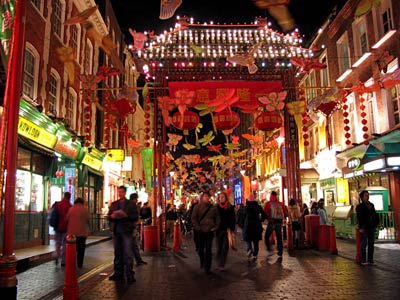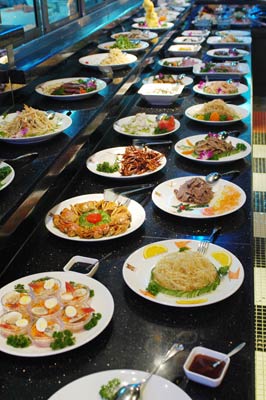"Wherever Chinese people go, Chinese restaurants will be opened." For overseas Chinese, Chinese restaurants are not only places to have meals but also an important means for subsistence. Survey data indicates that more than half of the overseas Chinese work inside the catering industry or related food industries. And in Britain, Germany and Netherlands this percentage is even higher, reaching about 80 percent.
Entrance of China Town, London
To some degree, the ups and downs of Chinese restaurants reflect the living conditions of overseas Chinese.
At 9:25 AM on November 20 the Quanjude (Group) Co., Ltd., China's famous roast duck chain, formally went public on the Shenzhen Stock Market.
Quanjude's listing provides a new development idea for other traditional Chinese brands. It's just like a shot in the arm for other catering giants seeking overseas expansion, according to Yang Liu, Secretary-General of the World Association of Chinese Cuisine (WACC).
As the economic backbone for overseas Chinese, Chinese restaurants may now have a brand new future after a history of more than 100 years that have included some hard times in the recent past.
Make a fortune via opening restaurants
A primary way for overseas Chinese to obtain a strong foothold in a foreign country is by opening a restaurant. Indeed, most first generation overseas Chinese began their adventures by opening restaurants. It seemed that this was their only employment choice.
Today it is difficult to tell when and where the first Chinese restaurant was opened outside of China. According to some documents, the first Chinese restaurant in the U.S. – the CanTon Chinese Restaurant – opened in San Francisco in 1849. By 1920, 25 percent of the Chinese Americans in the USA worked in the food business.
Currently the oldest existing Chinese restaurant in America is the Imperial Dynasty restaurant located in Hanford, California. Jiang Rong, a Guangdong railway worker, first opened this restaurant in 1883. Today his fourth generation family members are still operating this restaurant.
In 1914, the first Chinese restaurant in France, the "China Restaurant", opened. The boss, Li Shizeng, began operations as a bean curd company. Then, in order to make the cheese loving Frenchmen accept bean curd he opened a restaurant.
Chinese restaurants have been around for a long time but their real development has only begun over the past 20 years. In an interview with the Globe, Sun Xianggu, Chief of the Washington Chinese Restaurant Association, recalled, "I started my first restaurant in America in 1969 but we didn't sell Chinese dishes at that time because authentic Chinese cuisines didn't exist in America."
"In 1980 I opened an authentic Chinese restaurant. I invited Taiwanese chefs to come to work for me but we had no specific menu. The chefs just prepared some Jiangsu and Zhejiang dishes and steamed buns and cookies. But each time when the restaurant opened, customers would rush in. Since then Chinese restaurants featuring different dishes have began to emerge across America."
In the 1980s the Chinese mainland was experiencing the initial stages of its reform and opening up. Chinese people had opportunities to go abroad and foreigners also had chances to visit China. Many Taiwanese also sought further development overseas. All these factors prompted Chinese entrepreneurs to establish restaurants in many foreign countries and business boomed.
According to a 2006 survey, the UK had nearly 9,000 Chinese restaurants, about a quarter of all the restaurants; Netherlands had more than 2,200, accounting for 28 percent of all the restaurants and 85 percent of Chinese Dutchmen were working in restaurants; Chinese restaurants and fast food surpassed 7,000 in Germany and 80 percent of the Chinese Germans took jobs in the catering trade.
Harsh times witnessed by overseas Chinese restaurants
As an increasing number of Chinese restaurants have taken root in foreign countries, many problems have cropped up as well, including poor management and vicious competition through price cuts.
Since 2005, the French media and the press have reported many hygienic and quality control problems inside Chinese restaurants, making many Frenchmen worry about eating in Chinese restaurants.
Starting from March 30, 2006, the Portuguese government launched sudden health inspections in more than 100 Chinese restaurants. Unfortunately, more than 80 percent of them didn't pass Portuguese health code standards. Within five days 131 Chinese restaurants received fines and 14 were ordered to close down.
According to an insider, ongoing vicious competition between Chinese restaurants in Portugal had forced them all to lower their costs. Restaurant bosses understood the local government' health requirements but they failed to adhere to the regulations for various economic reasons.
Competition from local people is another challenge confronting Chinese restaurants. In Korea and Japan, Chinese cuisine is very popular. Yet many bosses of these transplanted Chinese restaurants are native Koreans or Japanese. And in America the fast growing Chinese snack bars such as the Panda Express and PFChang have American bosses.
Facing such competition, the older generation of overseas Chinese doesn't want their well-educated children to work in the food business. "Each time the WACC holds meetings, only older people in their 60s and 70s come to attend these meetings," Bian Jiang, Deputy Secretary-General of the WACC told the Globe.
Few overseas Chinese have passed on their restaurants as family businesses as the Imperial Dynasty restaurant has done – this is the fundamental reason why Chinese cuisine has not created famous overseas brands.
Authentic Chinese food to promote Chinese culture
Actually, some Chinese restaurants overseas are now expanding and prospering. WACC Secretary-General Yang Liu told the Globe, "In comparison with the past, Chinese overseas restaurants have improved a lot in recent years."
Yang further explained, "In the 1990s when I went to Japan, 30 percent of the people there preferred French cuisine; 40 percent loved the local cuisine; 15-20 percent favored Chinese cuisine. This year I visited Japan again. The entire restaurant industry was at a rather low ebb, yet more Chinese restaurants had been opened."
When visiting Argentina this year, Yang was pleasantly surprised to find authentic Northeastern Chinese dishes. "The restaurant we ate at is run by a Shenyang native. I ate mushroom and chicken stew and dumplings: typical Chinese dishes. When we went there we felt quite at home. In fact, many domestic restaurants don't cook as well as this restaurant," she commented.
Sun Xianggu opened a vegetarian restaurant called "Vegetable Garden" in Washington. The dishes are prepared with local vegetables by combining Chinese and Western cooking styles. Though dishes there are much more expensive than ordinary Chinese dishes made in other restaurants, many American customers patronize the place.
Yang believed that these restaurants represent the correct direction for Chinese cuisine. "They provide delicious Chinese food as well as fantastic Chinese culture. They have become very popular places to socialize," noted Yang.
Learn from France
Another important way to develop Chinese cuisine is to encourage domestic restaurant giants to expand outside China.
The Little Sheep Catering Chain specializes in hot pot and has sold its brand very well in Japan. Many other famous chain brands such as "Jinbaiwan" and "Huangjihuang" are seeking overseas development.
"In my opinion, Chinese cuisine will expand as food chains. Now Quanjude has been listed. More and more food businesses will go public in the future, this helps them get stronger and will enable them to expand outside of China," Yang Liu told the Globe.
According to her, enabling these catering enterprises to expand overseas is a very important way to promote Chinese cuisine around the world. With their considerable funds, professional talents as well as advanced management models these established domestic chains could quickly enter mainstream markets overseas. More importantly, they would give foreigners the chance to taste many kinds of delicious and authentic Chinese cuisines.
But in order to achieve this goal, "they need the support of our government, our embassies and foreign affairs departments," Yang added.
The French government has been very enthusiastic in promoting their cuisine culture globally and has done very well in this aspect, according to her. The French Ministry of Agriculture established the French Food Association (FFA) in 1961. And the FFA has been very successful in popularizing delicious French food over the past 40 years.
Bian Jiang believes that food is an indispensable part of a nation's culture. Chinese cuisine is varied and very special; it must be used to promote our culture.
(China.org.cn by Zhang Ming'ai, January 4, 2007)



